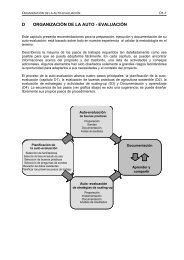cases from tanzania - Sustainet
cases from tanzania - Sustainet
cases from tanzania - Sustainet
Create successful ePaper yourself
Turn your PDF publications into a flip-book with our unique Google optimized e-Paper software.
Sustainable agriculture: A pathway out of poverty for East Africa’s rural poor<br />
Since 1993, the Kenyan government has undertaken a series of economic measures with the<br />
assistance of the World Bank and the International Monetary Fund. Similar to Tanzania, the<br />
government has eliminated price controls and import licensing, removed foreign exchange<br />
controls, privatized a range of publicly owned companies, reduced the number of civil servants,<br />
and introduced conservative fiscal and monetary policies.<br />
Food security is of paramount importance to Kenyan development policy, as is strongly<br />
implied in the country’s food policy document (Republic of Kenya, 1994), consecutive five<br />
year plans, and the Poverty Reduction Strategy Paper (Government of Kenya, 2002).<br />
Agricultural development strategies and poverty reduction<br />
A conducive policy environment is vital to stimulate agricultural development. The agricultural<br />
development strategies in Kenya and Tanzania are fairly similar. With the primary goal<br />
of self-sufficiency in basic food needs, the focus of agricultural policy reforms in Kenya<br />
and Tanzania has been to produce more food to enhance food security, and then to alleviate<br />
poverty. In line with market and price deregulation, top priorities have been to improve<br />
transportation and markets so as to increase people’s purchasing power and access to food.<br />
Promoting private sector involvement in production, processing, storage, input supply and<br />
marketing are also integral parts of the strategy. The private sector is supposed to take the<br />
leading role in input delivery and purchases of farm produce. The government’s role is<br />
confined to developing infrastructure, promoting supporting institutions, and monitoring<br />
performance. Providing market information is an important area that is neglected by governments;<br />
this gap is being filled in part by the private sector and NGOs.<br />
Elements of the strategies include the following.<br />
• Supporting agricultural research and extension and improving its effectiveness to<br />
generate improved technologies in production, storage and processing. Although research<br />
on plant and animal genetic improvement and cultural practices are usually in place, less<br />
attention is given to post-harvest technologies. Research is also encouraged to develop<br />
on- and off-farm storage and processing technologies to reduce post-harvest losses,<br />
boost returns to farmers and traders, and to increase overall food availability.<br />
• Improving rural infrastructure, including roads, market centres and storage facilities.<br />
The market currently performs very poorly because of poor infrastructure, inadequate<br />
organization of local marketing, and lack of storage facilities. Improving rural roads and<br />
feeder roads in particular is critically important to improve market access, both nationally<br />
and internationally. Rehabilitating or establishing physical marketing and storage facilities<br />
for both farmers and traders can enhance exchange and increase competitiveness.<br />
• Improving the collection and dissemination of market information so as to reach<br />
farmers and traders in a timely way, and strengthening of cooperative societies to enable<br />
them to compete in the market.<br />
• Promotion of cross-border trade with neighbouring countries and overseas. More<br />
focus is given to incentives for non-traditional export crops by liberalizing trade rules.<br />
96




